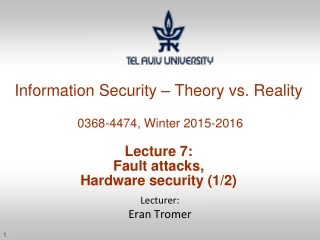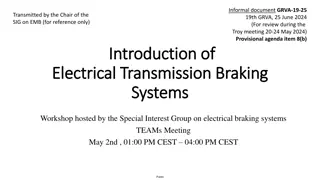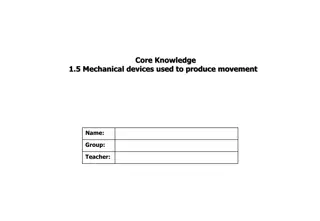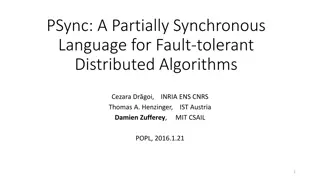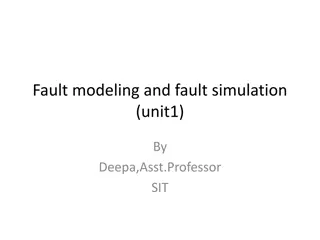Understanding Fault Diagnosis in Mechanical and Electrical Systems
Explore the essential methods and techniques for fault diagnosis in mechanical and electrical systems in industrial settings. Learn to identify different types of faults, utilize fault-finding aids, and rectify issues promptly to prevent future failures. Discover industry-recognized fault diagnosing methods such as Emergent Problem Sequence, The Half-Split Technique, and more. Enhance your skills in diagnosing system failures effectively and ensuring reliable performance.
Download Presentation

Please find below an Image/Link to download the presentation.
The content on the website is provided AS IS for your information and personal use only. It may not be sold, licensed, or shared on other websites without obtaining consent from the author. Download presentation by click this link. If you encounter any issues during the download, it is possible that the publisher has removed the file from their server.
E N D
Presentation Transcript
Lesson Objectives To be able to identify the four main types of fault diagnosing To be able to recognise fault finding aids and how to use them
Fault Diagnosis in Mechanical and Electrical Systems In Industry you will be expected to be able to diagnose faults on system failures in a timely manner and be able to rectify them in a way that ensures that they will not fail again in the future. This is not always an easy thing to do as the system that you have to work on may be complex with many components and not always in a suitable environment to work on.
The Four Industry Recognised Methods of Diagnosing Faults Emergent Problem Sequence The Half Split Technique The six-point method of fault diagnosis Input to output technique
Emergent Problem Sequence Identify that the machine/process is functioning differently than normal or not at all. Example: a process line is running out of sync Identify what has changed Example: one conveyer belt is running slower than normal
Emergent Problem Sequence Identify why that belt is running slower Example: check bearing temperatures, look for obstructions Establish the fault Example: the cowling on the drive motor had been bent and was rubbing on the cooling fan
Emergent Problem Sequence Rectify the fault Example: remove the cowling, straighten it and replace it Test the system.
The Half-Split Technique Half Split technique is used when fault finding on an electrical circuit. This can be used on all systems but for this example its on an electrical system! If you have power at a supply and ground but nothing at the consumer then check for a reading from halfway along the circuit and ground.
The Half Split Technique If a reading is present, there then pick a point about halfway between your present position and ground and check again. If a reading is still not present, then repeat the process from halfway of that and for every subsequent half until you had located the problem.
The Six-point Method of Fault Diagnosis 1. Test the system, i.e., take measurements or collect other evidence (data logs) 2. Analyse the readings (study trends, missing data) 3. Locate fault based on analysis (step 2) 4. Determine the original cause of the fault. ( i.e., find a method to prevent recurrence) 5. Repair the fault (bearing in mind step 4) 6. Restart the system (test)
Input to Output Technique Start by looking for a reading between the start and the first point If the reading is ok, then test from the start to the next point Continue this routine until the reading is lost This will then give you a working area to look at, between the last known position with a reading and the point where the reading was not present. Move the start point to the point of the last known reading and use the same method in more detail until the fault is found.
GROUP ACTIVITY IN YOUR GROUPS DISCUSS THE FAULT DIOGNOSIS TECHNIQUE YOU HAVE BEEN ALLOCATED. GIVE THREE ADVANTAGES AND THREE DISADVANTAGES YOU HAVE 15 MINUTES!
Fault Finding Aids Fault finding charts Functional system charts Algorithms Maintenance records Probability charts
Flow Charts A flow chart is a series of simple questions you ask about the system and fault by simply following simple Yes or No answers leads you to the fault and its cure.
Functional System Chart A Functional System Chart is a diagram of a working system. Other common Functional Charts could be . Schematic diagram Wiring diagram Sequence of operations diagrams
Algorithm's An Algorithm is a simple procedure or formula for solving a problem
Maintenance Records Maintenance records are written notes that provide documentation about the upkeep of a certain piece of equipment These will show all work carried out The first place to look in the event of a break down Official documents can be handwritten but more commonly stored on computer
Probability Charts http://i.stack.imgur.com/uxYS4.jpg The normal probability plot is a graphical technique to identify substantive departures from normality Deviations from a straight line suggest departures from normality These are then used to see where and when the system started to break down
Probability Probability is the measure of the likeliness that an event will occur. Always measured between 0 and 1 The higher the probability of an event, the more certain we are that the event will occur.
Probability A simple example is the toss of a coin. Since the two outcomes are equally probable, the probability of "heads" equals the probability of "tails", so the probability is 50% chance of either "heads" or "tails".
Quiz Time !!! A dice is thrown once. What is the probability that the score is a 6? Answer = 1/6 = 0.17
Quiz Time !!! The diagram shows a spinner made up of a piece of card in the shape of a regular pentagon, with a toothpick pushed through its centre. The five triangles are numbered from 1 to 5. The spinner is spun until it lands on one of the five edges of the pentagon. What is the probability that the number it lands on is odd? Answer = 3/5 = 0.6
Quiz Time !!! Each of the letters of the word MISSISSIPPI are written on separate pieces of paper that are then folded, put in a hat, and mixed thoroughly. One piece of paper is chosen from the hat. What is the probability it is an I? Answer = 4/11 = 0.36


